
BEIJING: The life cycle of a single COVID-19 nucleic acid diagnostic test in China could result in emissions of 0.6 kg of carbon dioxide, nearly half of a person's daily electricity use in the country, according to a group of researchers.
Production of test kits, transportation, testing and wastewater treatment contribute to greenhouse gas (GHG) emissions and air and water pollution, according to researchers in a new study published last week in the journal Environmental Science and Technology.
Improved approaches to wastewater treatment, low-carbon transport, and the use of more environmentally friendly materials should be considered to achieve sustainable and green diagnostics, the researchers said, as the world grapples with the coronavirus pandemic and China's leadership. countries continue to fight.
Implement a zero-Covid policy with nationwide mass testing to contain the outbreak.
"Even though COVID-19 diagnostics are critical to ending the pandemic, their environmental impact should not be overlooked," wrote Guangdong University of Technology, Beijing University of Chemical Technology (BUCT), and the University of Michigan, Ann Arbor. . paper.
We often overlook the environmental impact of a small (test) kit. However, when performed millions of times on a daily basis around the world, there will undoubtedly be some impact," Su Xin, a professor of biomedical engineering at BUCT and one of the paper's authors, told the Post last week.
Since the outbreak in Shanghai in March, China has implemented strict COVID-19 policies. Lockdowns and travel restrictions have been imposed in dozens of cities across the country. Since March, residents of some cities, such as the Southern Technology Center Shenzhen, have been required to take a COVID-19 test every 24, 48 or 72 hours through a vast network of free testing facilities.
Researchers used a full cradle-to-critical life-cycle approach to examine the environmental impact of a single COVID-19 test in China, including GHG emissions, heavy metals and water pollutants.
A typical COVID-19 test begins with a technician collecting respiratory material from a patient's nose or mouth with a disposable swab, sealing it in a tube containing the virus transport medium, and transporting it to a diagnostic from the testing station. transfers to the laboratory.
This is followed by RNA extraction, nucleic acid amplification and laboratory testing. The medical waste is then disinfected and incinerated at high temperatures.
The researchers found that the total GHG emissions per test amounted to 612.9 grams, with most carbon dioxide and methane accounting for the remainder. "The combined GHG emissions of the two nucleic tests are roughly equivalent to emissions from electricity that a Chinese resident uses on a daily basis," Su explained.
China has not disclosed the total number of such tests conducted since the outbreak of COVID-19 in 2020. However, according to data provider Our World in Data, China has conducted more than 9 billion COVID-19 tests since the beginning of 2020 to April 11. This year, which is ten times more than the United States, is the second largest country in terms of the number of COVID-19 tests performed.
This means that COVID-19 tests in China could result in at least 5.4 million tonnes of GHG emissions by 2020. The country, committed to achieving net-zero carbon emissions by 2060, emitted more than 11.9 billion tonnes of GHG in 2021. , accounting for 33% of the global total.
A breakdown of the COVID-19 testing process shows that wastewater treatment accounts for the majority of emissions, which account for 71.3 per cent of the total. The production of test kits and transport is 14.5 and 13.3 per cent of the total, respectively.
The wastewater treatment process is a heavy emitter as all waste is sterilized with high-temperature steam and incinerated at temperatures of 850 to 1,200 °C, both of which require significant energy systems.
Transportation processes are also a concern, as test kits must be kept at minus 20 °C during transport to ensure materials remain active, and conventional diesel vans are currently the most common existing medical cold-chain logistics pathway. China. Long-distance transport requires additional cooling, which consumes more fuel.
According to the study, the average distribution distance of a test kit from manufacturer to testing center in China is about 5,960 kilometres.
The GHG emissions from the testing process are caused by the testing equipment's electricity consumption, which typically takes 7 to 15 minutes to extract nucleic acids, followed by one and a half hours in a polymerase chain reaction thermal cycler for the testing results.
According to the researchers, the environmental impact of Covid-19 tests could be even greater in reality because the impact of transporting medical waste from testing centres to waste treatment plants is excluded due to a lack of data.
They proposed three potential strategies for reducing the environmental impact of Covid-19 testing: using more environmentally friendly and recyclable materials in testing kits, revising existing medical waste treatment methods, and using electric vehicles during transportation.
"I hope relevant companies and policymakers pay attention to this issue," Su said. "Covid-19 testing is still required in the current pandemic situation, but there should be ways to improve its environmental impact."
India-China armies will be withdrawn from LAC.., Indian Army Chief to reach Ladakh today
India deposited artillery on China border, preparations began to give befitting reply to Dragon
Now China will not bother, India building Air Force base on LAC